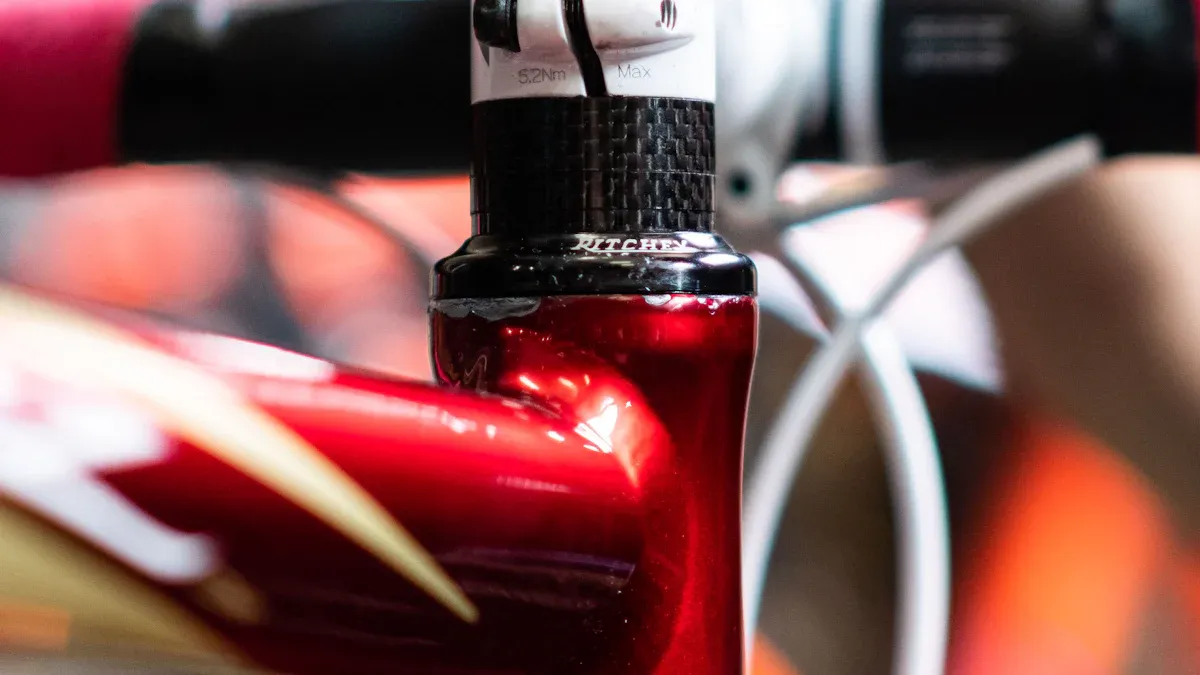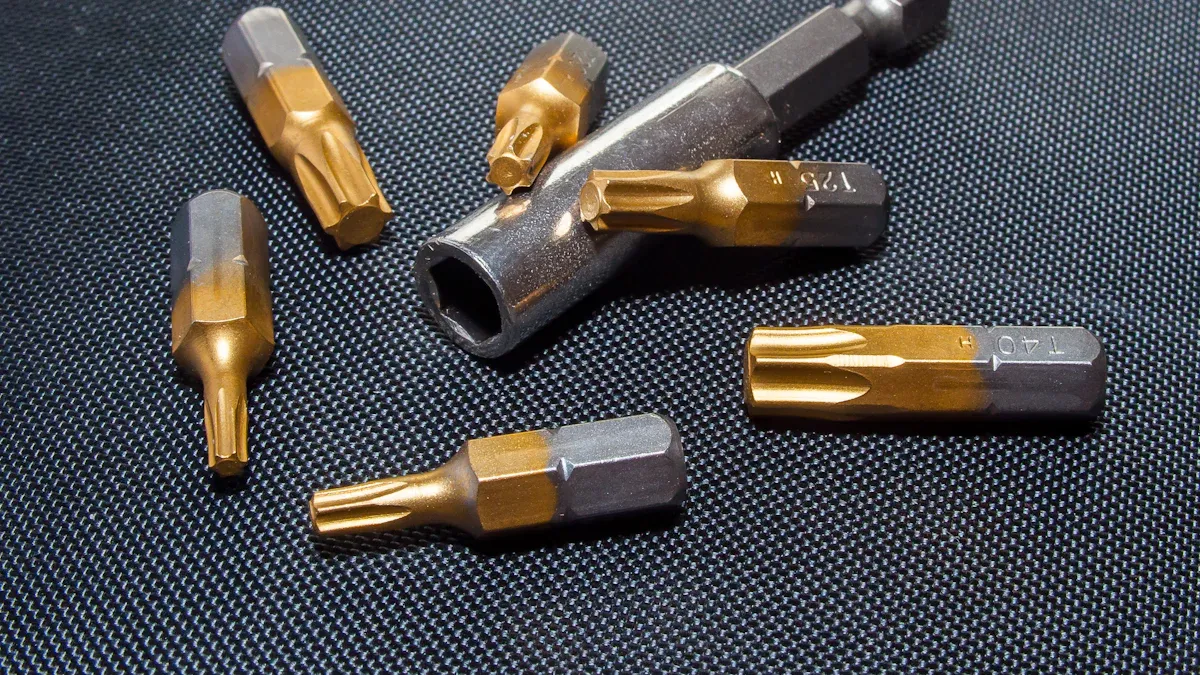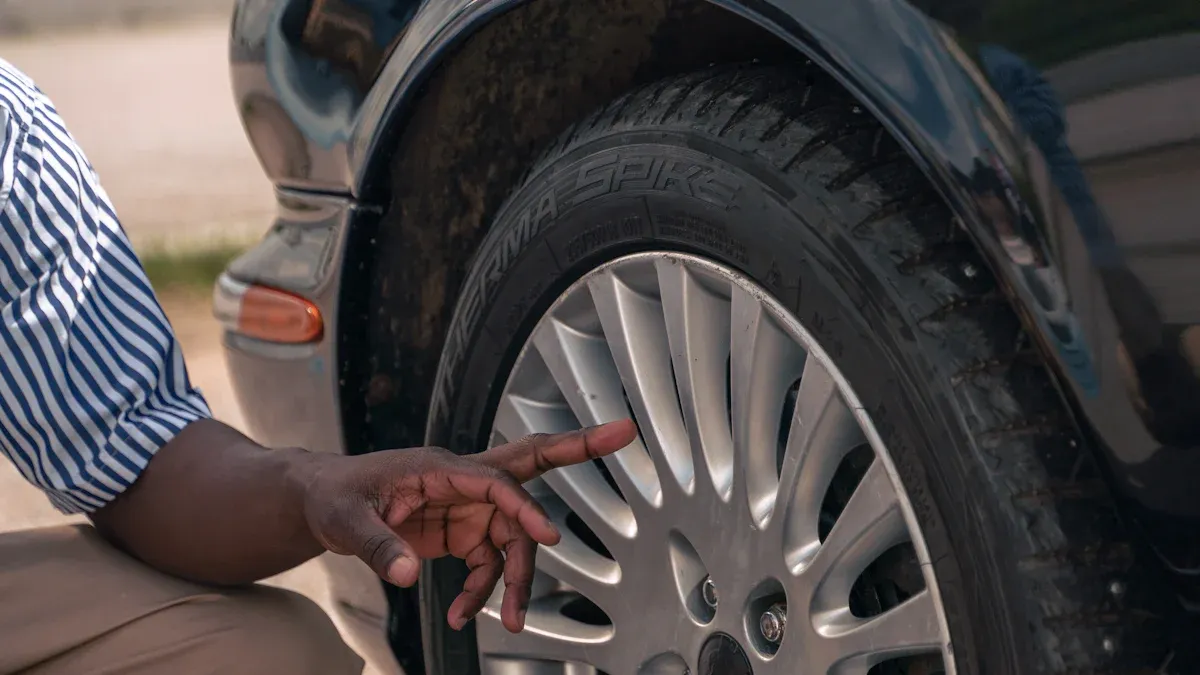

fortuneau
July 16, 2025
Metal Valve Stems Maintenance and Safety Tips

You depend on metal valve stems to keep your tires properly sealed and safe. Clean and inspect your valve stems often to prevent leaks and blowouts. Securely fasten each stem to help maintain reliability on the road. Always check for signs of wear or corrosion.
Tip: Replace metal valve stems if you see any cracks or damage. This simple step protects you and extends the life of your tires.
Why Metal Valve Stems Require Proper Maintenance

Preventing Tire Leaks and Blowouts with Metal Valve Stems
You want your tires to stay safe and reliable on every drive. Metal valve stems play a key role in keeping air inside your tires. Many drivers have found that rubber stems often fail, especially when used with TPMS sensors. These failures can lead to sudden air loss and even emergency stops. When you use metal clamp-in valves, you lower the risk of leaks and blowouts. Metal valve stems, including aluminum valve stems and brass valve stems, offer better durability than rubber types. Some users switched from rubber to high-pressure metal valve stems and reported no problems for years. This makes metal clamp-in valves a smart choice for vehicles that need extra safety.
Tip: Always check your valve stems for signs of wear or damage before long trips.
Extending the Lifespan of Tire Valve Stems
You can extend the life of your tire valve stems by choosing the right types and materials. Aluminum valve stems and brass valve stems both resist corrosion and stand up to tough conditions. These types work well for heavy-duty applications and high-pressure applications. When you use high-pressure metal clamp-in tire valves, you help your tires last longer. Regular checks and cleaning also keep your valve stems in top shape. Many automotive experts recommend metal clamp-in valves for their long-term durability.
| Valve Stem Type | Material | Durability | Best Use Cases |
|---|---|---|---|
| Rubber | Rubber | Low | Light vehicles |
| Aluminum valve stems | Aluminum | High | High-pressure, trucks |
| Brass valve stems | Brass | High | Heavy-duty, commercial |
Ensuring Safe Driving with High-Pressure Metal Clamp-In Tire Valve
You depend on your valve stems for safe driving, especially in vehicles that carry heavy loads. High-pressure metal valve stems, such as aluminum and brass types, handle more stress than rubber ones. These metal clamp-in valves stay secure even when you drive at high speeds or carry heavy cargo. Many drivers and TPMS manufacturers recommend metal valve stems for their strength and compatibility. When you use the right types of valve stems, you protect your tires and improve your vehicle’s safety. Always choose quality aluminum valve stems or brass valve stems for the best results.
Regular Inspection and Cleaning of Valve Stems

Regular inspection and cleaning help you keep your valve stems in top condition. You can prevent problems before they start by following a simple routine. This section will guide you through how often to check your valve stems, what to look for, and how to clean them properly.
Inspection Frequency for Metal Valve Stems
You should inspect your valve stems at least once a month. Many experts recommend checking them every time you check your tire pressure. If you drive in harsh weather or on rough roads, you may need to inspect them more often. Look at your valve stems before long trips or after driving through mud, snow, or salt. These conditions can speed up wear and make problems harder to spot.
Tip: Make a habit of checking your valve stems when you fill up with gas. This routine helps you catch issues early.
Identifying Corrosion, Cracks, and Leaks in Valve Stems
You need to look closely at your valve stems to spot signs of trouble. Corrosion often appears as white, green, or brown spots on the metal. Cracks may look like tiny lines or splits near the base or along the stem. Leaks can show up as a slow loss of tire pressure or bubbles if you spray soapy water on the stem.
Here is a quick checklist to help you:
- Check for any discoloration or rough patches. These may signal corrosion.
- Look for cracks or splits, especially near the base.
- Press down on the valve stem gently. It should feel firm, not loose.
- Listen for a hissing sound, which means air is escaping.
- Spray soapy water on the valve stem. Bubbles mean you have a leak.
If you find any of these problems, replace the valve stem right away. This action keeps your tires safe and prevents bigger issues.
Cleaning Steps for Metal Valve Stems
You can clean your valve stems with a few simple steps. Clean stems help you spot damage and keep your tires sealed tight. Dirt and road salt can hide cracks or speed up corrosion, so regular cleaning is important.
Follow these steps:
- Use a soft brush or cloth to remove loose dirt from the valve stem.
- Mix mild soap with warm water. Dip your cloth in the soapy water.
- Wipe the valve stem gently. Pay close attention to the base and threads.
- Rinse with clean water to remove any soap.
- Dry the valve stem with a clean towel.
Note: Do not use harsh chemicals or wire brushes. These can scratch the surface and reduce corrosion resistance.
You should clean your valve stems every time you wash your car. Clean stems last longer and work better. Good cleaning habits help you spot problems early and keep your tires safe.
Proper Installation and Torque for Metal Valve Stems
Correct installation of valve stems helps you avoid leaks and keeps your tires safe. You need to use the right tools, follow the manufacturer’s instructions, and make sure each stem fits tightly. These steps help you get the best performance from your metal clamp-in valves.
Using Correct Tools for Tire Valve Stems
You need the right tools to install valve stems properly. A valve stem puller helps you insert the stem without damaging it. A torque wrench lets you tighten the nut to the correct level. You should also use a valve core tool to install or remove the core inside the stem. These tools help you avoid over-tightening or under-tightening, which can cause leaks.
Here is a list of tools you should have:
- Valve stem puller
- Torque wrench (with the correct setting for your stem)
- Valve core tool
- Clean cloth for wiping the area
Tip: Always check your tools before you start. Clean tools help you avoid dirt getting into the valve stems.
Following Manufacturer Guidelines for High-Pressure Metal Clamp-In Tire Valve
You should always read and follow the manufacturer’s instructions when installing a high-pressure metal clamp-in tire valve. Each brand may have different torque settings or installation steps. The instructions tell you how much to tighten the nut and what type of washer or seal to use. If you skip these steps, you risk damaging the valve stems or causing leaks.
Manufacturers often provide a chart with torque values. For example, some metal clamp-in valves require tightening to 35-55 inch-pounds. You should use a torque wrench to match this value. If you do not have the chart, contact the manufacturer or check their website.
| Valve Stem Type | Typical Torque (inch-pounds) | Washer Type |
|---|---|---|
| Aluminum clamp-in | 35-55 | Rubber/Metal |
| Brass clamp-in | 35-55 | Rubber/Metal |
Note: Using the wrong torque can cause the stem to loosen or break. Always double-check the value before tightening.
Ensuring a Secure Fit for Valve Stems
You need to make sure each valve stem fits tightly in the wheel hole. A loose fit can cause air leaks or let water enter the tire. After you install the stem, check that it does not wiggle or move. You should also inspect the rubber grommet or washer for a good seal. If you see any gaps, remove the stem and try again.
Follow these steps for a secure fit:
- Insert the valve stem through the wheel hole.
- Place the washer and nut on the outside.
- Tighten the nut with a torque wrench to the correct value.
- Check the stem for movement by gently wiggling it.
- Spray soapy water around the base and look for bubbles.
If you see bubbles, air is leaking. Remove the stem and reinstall it for a better seal.
Metal clamp-in valves give you extra strength and a better seal than rubber types. You should always check the fit after installation. This habit helps you avoid problems on the road and keeps your tires safe.
Common Issues with Metal Valve Stems and Solutions
Addressing Corrosion on Metal Valve Stems
Corrosion can weaken valve stems and cause leaks. You may notice white, green, or brown spots on the surface. These spots show that corrosion has started. If you drive in areas with road salt or high humidity, you should check your valve stems more often. To fight corrosion, clean your valve stems with mild soap and water. Dry them well after washing. You can also use a light coating of silicone spray to add extra corrosion resistance. This spray helps block moisture and keeps the metal strong. If you see deep pitting or flaking, replace the valve stem right away. This step keeps your tires safe.
Tip: Always use valve stem caps. Caps keep out water and dirt, which helps prevent corrosion.
Fixing Air Leaks in Tire Valve Stems
Air leaks can lower tire pressure and make driving unsafe. You can find leaks by spraying soapy water on the valve stem. If you see bubbles, air is escaping. Tighten the valve core with a valve core tool. If the leak continues, remove the valve stem and check for damage. Replace the stem if you see cracks or worn seals. Always use quality tire valve stems for the best seal. Proper installation and regular checks help stop leaks before they become a problem.
Handling Loose or Damaged Valve Stems
Loose or damaged valve stems can cause sudden air loss. You should check the fit by gently moving the stem. If it wiggles, tighten the mounting nut with a torque wrench. Follow the manufacturer’s torque settings for a secure fit. If the stem stays loose or shows signs of damage, replace it. Never ignore a damaged valve stem. Quick action keeps your tires safe and your vehicle on the road.
Alert: If you feel unsure about fixing valve stems, ask a professional for help. Safety always comes first.
Safety Tips for Handling Metal Valve Stems
Working Safely with Pressurized Tires and Valve Stems
You must treat pressurized tires with care. Working on valve stems while the tire is pressurized can be dangerous. Always let a professional handle the removal or adjustment of valve stems on a tire that still holds air. Professionals have the right tools and training to do this job safely.
Follow these steps to stay safe:
- Inspect your valve stems regularly for cracks, leaks, or signs of damage. Do not forget to check the spare tire.
- Never try to remove or replace valve stems on a pressurized tire by yourself.
- Use plastic valve caps instead of metal ones. Plastic caps help prevent corrosion and sticking.
- If you notice any damage or stiffness in the valve stem, stop using the tire and get it checked by a professional.
Tip: Always include the spare tire in your inspection routine. A damaged valve stem on a spare can leave you stranded.
Personal Protective Equipment for Valve Stem Maintenance
You should wear the right gear when working with tires and valve stems. Gloves protect your hands from sharp edges and chemicals. Safety glasses keep your eyes safe from dust or debris. Closed-toe shoes shield your feet if you drop a tool or part. Wearing the right equipment helps you avoid injuries and makes your work safer.
- Wear gloves to protect your hands.
- Use safety glasses to guard your eyes.
- Choose sturdy shoes for foot protection.
Note: Even simple tasks like checking valve stems can cause injury if you do not use proper protection.
When to Seek Professional Help for Metal Valve Stems
Sometimes, you need expert help. If you find cracks, leaks, or corrosion on your valve stems, visit a tire shop. Professionals can replace the entire valve stem assembly, including the cap, core, and sensor if needed. This ensures your tire stays safe and works well. If you feel unsure about any step, ask a professional. Your safety always comes first.
If you notice any problem with your valve stems, do not wait. Quick action keeps your tires reliable and your vehicle safe.
Best Practices for Long-Term Reliability of Metal Valve Stems
Routine Maintenance Schedule for Valve Stems
You should set a regular schedule to check your tire valve stems. Monthly inspections help you spot problems early. Look for signs of wear, corrosion, or leaks. Many automotive experts recommend checking valve stems every time you check tire pressure. You can use a simple checklist:
- Inspect for cracks or splits.
- Check for corrosion on aluminum and brass valve stems.
- Test for leaks with soapy water.
- Make sure the stem feels secure.
If you use tubeless rubber snap-in tire valve or tubeless snap-in high-pressure tire valve, you should check them more often. These types can wear faster in harsh weather. High-pressure snap-in valves need extra attention if you drive heavy vehicles or carry loads.
Tip: Mark your calendar for a monthly valve stem check. This habit boosts reliability and keeps your vehicle performance strong.
Using Quality Replacement Parts from Trusted Manufacturers
You should always choose quality parts when replacing valve stems. Trusted brands use strong materials like aluminum and brass. These metals offer high durability and resist corrosion. Aluminum valve stems work well for most vehicles. Brass valve stems are best for heavy-duty vehicles and commercial trucks. Never mix different types on the same wheel. Using the same type ensures a proper seal and long life.
| Valve Stem Material | Best For | Durability | Common Types Used |
|---|---|---|---|
| Aluminum | Passenger vehicles | High | Aluminum valve stems, tubeless snap-in |
| Brass | Heavy-duty vehicles | High | Brass valve stems, high-pressure snap-in |
Tubeless rubber snap-in tire valve and tubeless snap-in high-pressure tire valve both need careful selection. Always buy from a trusted automotive supplier. This step protects your tires and improves reliability.
Monitoring Tire Pressure with Metal Valve Stems
You should monitor tire pressure often. Metal valve stems, like aluminum valve stems and brass valve stems, help keep air inside your tires. These types work better than rubber stems for holding pressure. Use a digital gauge to check pressure at least once a month. High-pressure snap-in valves and tubeless snap-in high-pressure tire valve need special care. If you drive different vehicles, remember that each type may need a different pressure range.
Note: Keeping the right pressure improves durability and safety. It also helps your tires last longer.
You can trust aluminum and brass valve stems for strong performance. These types support many vehicles and help you avoid sudden air loss. Good habits with tire valve stems lead to better vehicle performance and long-term reliability.
You keep your tires safe by checking metal valve stems often. Clean them, look for damage, and use only trusted, high-quality parts. Follow these steps:
- Inspect valve stems every month.
- Clean and dry stems to prevent corrosion.
- Replace damaged or worn stems right away.
Regular checks and professional inspections give you peace of mind. Quality valve stems help you drive safely every day.
FAQ
How often should you replace metal valve stems?
You should replace metal valve stems every time you change your tires. If you see corrosion, cracks, or leaks, replace them right away. Regular checks help you spot problems early and keep your tires safe.
Can you reuse metal valve stems after removing them?
You should not reuse metal valve stems. Removing and reinstalling them can damage the seal. Always use new, high-quality valve stems for the best safety and performance.
What causes corrosion on metal valve stems?
Road salt, moisture, and chemicals can cause corrosion on metal valve stems. You can prevent corrosion by cleaning the stems often and using valve caps. Corrosion weakens the stem and may lead to air leaks.
Do metal valve stems work with tire pressure monitoring systems (TPMS)?
Yes, metal valve stems work well with most TPMS sensors. Many TPMS manufacturers recommend metal stems because they handle higher pressure and last longer than rubber stems.
Why do you need valve stem caps?
Valve stem caps keep out dirt, water, and debris. They help prevent leaks and protect the valve core. Always use caps to extend the life of your valve stems and keep your tires safe.





